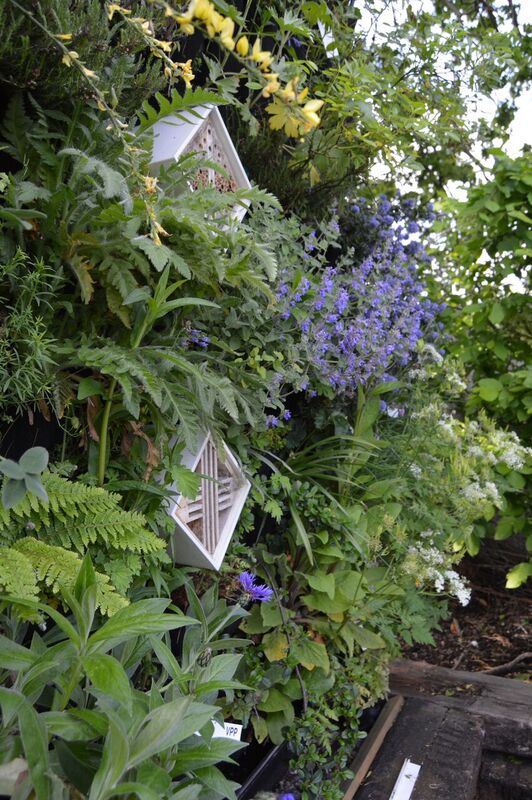Scotscape Landscaping Ltd. Bug Life and Wildlife World have worked together to create the ‘Perfect Pollinator’ living wall in support of Defra’s Pollinator Campaign, directed at bringing pollinating insects back into our urban areas.
Planted with a range of plants which are perfect for pollinating insects, the Scotscape Living Wall system supports large architectural growth, making pollen more abundant and also enabling the easy incorporation of Wildlife World’s Bug Homes within the wall.
Useful Facts about bug homes on living walls
- Solitary bees which the bug homes are designed for do not sting as they lack the ability to do so.
- The bees most likely to use the bug homes first appear early in the year anytime from early April dependent on weather and how far south. By mid-May you would expect to see a fair number of the nesting tubes used.
- 8 out of 10 wildflowers in the UK would disappear without pollination.
- Pollinators are worth over £0.5 billion per annum to the UK farming sector to replace them would cost around £2 billion in manual hand pollination
- Over 97% (an area the size of Wales) of all flower-rich grasslands have been lost in Britain since the 1930s, reducing pollen and nectar sources and leading to a serious decline in the wildlife dependent on wildflower-rich habitat.
- Our pollinators are at risk due to loss of habitat both in terms of nesting sites and food. There are a number of causes including paving over of the urban environment, change to modern cement mixes that they can’t burrow into, large scale farming including extensive use of herbicides that is creating monoculture in the countryside lacking in food sources.
- The urban environment is now relatively pesticide free and therefore with the right planting and home provision it can provide the oasis needed to sustain our pollinators.
- Urban areas provide enormous opportunities for habitat creation and can contain a remarkable number of species; for example 35% of UK hoverfly species were recorded in a single garden.
The Perfect Pollinator Wall – Plant list
Optimum plants for encouraging pollinating insects include:
| Pollinator Plant List | |
| Lungwort (pulmonaria species)
Mahonia ( small or dwarf if possible) Fritillaria Meleagris (snakeshead) Ceanothus (small variety if possible) Winter honeysuckle (evergreen shrub) Normal honeysuckle Centaurea Montana Erica carnea Rhododendron (dwarf) Foxgloves Catmint Knapweeds Lupins Organium Vulagre Calamintha species Speedwells veronica Eryngium Echinops Myrtle Aquilegia Erica Cinerea Escallonia Aster novi-angliae cultivars (Michaelmas) |
Hardy Fuchsias
Erica vagans Sedum Motrona Succisa Pratensis Marsh Woundwort Papaver rhoeas Meconopsis cambric Birds foot trefoil Red & white clover Red dead nettle Bush vetch Common vetch Comfrey White melilot Woundworts Musk and marsh mallow Toadflax Vipers bugloss Burdock Red bartsia Black horehound Hawkbits
|
Scotscape Landscaping Ltd. Scotscape designs, installs and maintains living walls across the UK. Our unique and flexible living wall system is adopted by commercial and private clients owing to its lightweight construction, speed of installation and the horticultural and engineering expertise provided by the Scotscape team. www.scotscape.net
Wildlife World – With a strong commitment to the conservation of species, Wildlife World’s efforts to produce innovative and valuable nesting habitats and feeders for birds, mammals, amphibians and insects are benefiting wildlife all over Europe and are an on-going contribution to the survival of species in both the UK and other countries. Their commitment to innovative features has gained the company an enviable reputation as leaders in the design and manufacture of products for wildlife. www.wildlifeworld.co.uk
Buglife-The Invertebrate Conservation Trust is the only charity in Europe devoted to the conservation of all invertebrates, and is actively working to save Britain’s rarest bugs, bees, butterflies, ants, worms, beetles and many more fascinating invertebrates. www.buglife.org.uk


